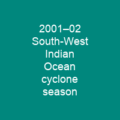Cyclone Joy

Severe Tropical Cyclone Joy struck Australia in late 1990, causing the third highest floods on record in Rockhampton, Queensland. On 18 December, it was named Joy, becoming the 2nd named storm of the 1990–91 Australian region cyclone season. After turning southwest, Joy developed a well-defined eye and strengthened to maximum sustained winds of 165 kmh while approaching Cairns. Brushing the city with strong winds, the cyclone soon weakened and turned southeast. Joy later curved back southwest, making landfall near Townsville, Queensland on 26 December. It dissipated the next day; remnant moisture continued as torrential rainfall over Queensland for two weeks.
About Cyclone Joy in brief
 Severe Tropical Cyclone Joy struck Australia in late 1990, causing the third highest floods on record in Rockhampton, Queensland. This cyclone began as a weak tropical low near the Solomon Islands, and initially moved westward. On 18 December, it was named Joy, becoming the 2nd named storm of the 1990–91 Australian region cyclone season. After turning southwest, Joy developed a well-defined eye and strengthened to maximum sustained winds of 165 kmh while approaching Cairns in Far North Queensland. Brushing the city with strong winds, the cyclone soon weakened and turned southeast. Joy later curved back southwest, making landfall near Townsville, Queensland on 26 December. It dissipated the next day; remnant moisture continued as torrential rainfall over Queensland for two weeks. Overall, Joy killed six people and caused A$300 million in damage. Afterwards, the Queensland government issued a disaster declaration for about 30% of the state, and the name Joy was retired from the list of tropical cyclone names. A remnant system persisted into early January, producing rainfall across Queensland before Joy struck early January. The storm moisture alleviated drought conditions and diminished fires near Sydney. The Fitzroy River discharged about 18 trillion litres of freshwater into Keppel Bay over 25 days.
Severe Tropical Cyclone Joy struck Australia in late 1990, causing the third highest floods on record in Rockhampton, Queensland. This cyclone began as a weak tropical low near the Solomon Islands, and initially moved westward. On 18 December, it was named Joy, becoming the 2nd named storm of the 1990–91 Australian region cyclone season. After turning southwest, Joy developed a well-defined eye and strengthened to maximum sustained winds of 165 kmh while approaching Cairns in Far North Queensland. Brushing the city with strong winds, the cyclone soon weakened and turned southeast. Joy later curved back southwest, making landfall near Townsville, Queensland on 26 December. It dissipated the next day; remnant moisture continued as torrential rainfall over Queensland for two weeks. Overall, Joy killed six people and caused A$300 million in damage. Afterwards, the Queensland government issued a disaster declaration for about 30% of the state, and the name Joy was retired from the list of tropical cyclone names. A remnant system persisted into early January, producing rainfall across Queensland before Joy struck early January. The storm moisture alleviated drought conditions and diminished fires near Sydney. The Fitzroy River discharged about 18 trillion litres of freshwater into Keppel Bay over 25 days.
In turn, the Great Barrier Reef suffered biological damage from coral bleaching and decreased salinity. The military evacuated its fleet of Blackhawk helicopters from RAAF Base Hope Island in advance of the storm. A man required rescue by helicopter from Hope Island by helicopter in advance of the storm threat. Officials set up evacuation centres on the mainland and put the Australian Army on standby. The Australian Army put its Blackhawk fleet of helicopters on standby before Christmas before the storm caused shopping malls and the airport to close close to the airport just before Christmas. A meteorologist from Darwin later apologised that the name was used so close to Christmas, although \”Joy\” was predetermined by a rotating list of list of storm names. In mid-December, a monsoon trough persisted along the west Pacific Ocean, spawning a pair of tropical disturbances both north and south of the equator. During the next few days, the system passed south of Australia while slowly organizing. The Australia Bureau of Meteorology began tracking it, naming the system \”Joy \” after it upgraded the low to tropicalcyclone status.
You want to know more about Cyclone Joy?
This page is based on the article Cyclone Joy published in Wikipedia (as of Dec. 05, 2020) and was automatically summarized using artificial intelligence.












